Code orange applies for very high temperatures from late Tuesday morning until the evening, with maximum temperatures of 38-39°C for the central and southern regions of the Netherlands.
The heat will be dissipated on Wednesday. While temperatures in the east can still be hovering around 30°C.
(Extreme) heat can have health consequences. Especially for the elderly, small children and people with fragile health though healthy people could also be affected. As a consequence, the National Heat Plan will come into effect on Monday 18 July 2022. The heat in much of Europe can also create smog. People who are sensitive to smog can get complaints as a result. That is why a smog warning will apply from Monday 18 July in addition to the heat plan.
Vulnerable groups
Warm weather can mean that people who are unable to properly care for themselves can experience discomfort (such as fatigue, headaches and concentration problems) and more serious health problems (such as dehydration and heat stroke). The elderly are the largest vulnerable group because they are less able to control their body temperature and are less likely to feel thirsty. In addition, others can easily experience discomfort or health problems without taking measures; think of people with chronic conditions, people in social isolation, the homeless, overweight people and (very) young children. Both extreme heat and high concentrations of ozone in the summer (summer smog) affect everyone.
The most important tips to help avoid discomfort and health problems from the heat and smog are:
- Drinking enough (water);
- Keeping the house cool by means of blinds, fans or air conditioning;
- Limit physical exertion in the afternoon and early evening.
In addition, it is wise to avoid sunburn. Good protection is important for this.
Smog from ozone
Smog from ozone is created by the accumulation of air pollution on sunny days. RIVM advises people who are sensitive to smog to stay indoors and to limit heavy physical exertion. In Europe, more than 180 micrograms of ozone per cubic meter of air results in a smog warning. When this value exceeds 240 micrograms of ozone per cubic meter of air then a smog alert replaces the warning.
















